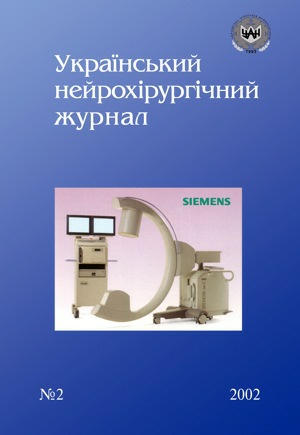Estimation of EEG and USDG indices in patients suffering of drug resistent epilepsy and epilepsy seizures during treatment with use TMS on the occipital area
Abstract
Clinical, electroencephalographycal and transcranial ultrasound dopplerography parameters were investigated in 36 patients suffering of drug resistent epilepsy and epilepsy seizures in dynamics of the combined treatment with use low-frequency transcranial magnetic stimulation (TMS) of the occipital area. Changes were estimated according to a control above seizures, index of paroxysm and spectral density of power on various frequency ranges, and cerebrovascular reactivity. The interrelation of clinical improvement with researched parameters on a background of application low-frequency ТМС of occipital area was established.References
1. Гайдар Б. В. Принципы оптимизации церебральной гемодинамики при нейрохирургической патологии головного мозга: Автореф. дис. … д-ра мед. наук. — Л., 1990. — 42 с.
2. Гнездицкий В.В. Обратная задача ЭЭГ и клиническая электроэнцефалография. — Таганрог: Изд-во ТРГУ, 2000. — 636 с.
3. Громов С.А. Критерии выздоровления больных эпилепсией // Невролог. вестн. — 1997. — №3. — С.71.
4. Зенков Л.Р. Клиническая электроэнцефалография с элементами эпилептологии. — Таганрог: Изд-во ТРГУ, 1996. — 357 с.
5. Кузнецов В.И. Общая химия: тенденции к развитию. — М.: Высш. шк., 1989. — 288 с.
6. Свистов Д.В. Полуколичественная допплерографическая оценка ауторегуляции кровоснабжения головного мозга в норме и при нейрохирургической патологии: Метод. разработки. — СПб, 1997.
7. Ультразвуковая допплеровская диагностика сосудистых заболеваний / Под ред. Ю.М. Никитина, А.И. Труханова. — СПб: ЦМ Видар, 1998. — 432 с.
8. Эпилепсия и судорожные синдромы у детей: Руководство для врачей / Под ред. П.А.Темина, М.Ю. Никаноровой. — 2-е изд., перераб. и доп. — М.:Медицина, 1999. — 656 с.
9. Barker A.T., Jalinous R., Freeston I.L. Non-invasive magnetic stimulation of the human motor cortex // J.Physiol. — 1985. — V.369. — P.3.
10. Giller C.A. // Acta Neurochir. — 1991. — V.108, Fasc. 1—2. — P.7—14.
11. Lisanby S.H., Luber B.L., Schroeder C. et al. rTMS in primates: intracerebral measurement of rTMS and ECS induced voltage in vivo // Electroencephalogr. Clin. Neurophysiol. — 1998. — V.107. — P. 79.
12. Lisanby S.H., Luber B.M., Finck D. et al. Magnetic stimulation therapy: a novel convulsive technique // Biological Psychiatry. — 1999. — N 45. — P. 64—65.
13. Markus H.S., Harrison M.J.G. // Stroke. — 1992. — V. 23, N 5. — P.668—673.
14. Ringelstein E.B., Sievers C., Ecker S. et al. // Stroke. — 1989. — V.19, N 8. — P.963—969.
15. Tergau F., Naumann U., Paulus W. et al. Low-frequency repetitive transcranial magnetic stimulation improves intractable epilepsy // Lancet. — 1999. — P. 353.
16. Wassermann E.M., Cohen L.G., Flitman S.S. et al. Seizures in healthy people with repeated “safe” trains of transcranial magnetic stimuli // Lancet. — 1996. — N 347. — P. 825—826.
17. Wassermann E.M. Risk and safety of repetitive transcranial magnetic stimulation: report and suggested guidelines from the International Workshop in the Safety of Repetitive Transcranial Magnetic Stimulation // Electroencephalogr. Clin. Neurophysiol. — 1998. — V.108. — P. 1—16.
18. Weissman J.D., Epstein C.M., Davey K.R. Magnetic brain stimulation and brain size: relevance to animal studies // Electroencephalogr. Clin. Neurophysiol. — 1992. — V.85. — P. 215—219.
19. Ziemann U., Steinhoff B.J., Tergau F., Paulus W. Transcranial magnetic stimulation: its current role in epilepsy research // Epilepsy Res. — 1998. — V.30. — P. 11—30.
Downloads
How to Cite
Issue
Section
License
Copyright (c) 2002 A. V. Zhylinska, L. L. Chebotaryova

This work is licensed under a Creative Commons Attribution 4.0 International License.
Ukrainian Neurosurgical Journal abides by the CREATIVE COMMONS copyright rights and permissions for open access journals.
Authors, who are published in this Journal, agree to the following conditions:
1. The authors reserve the right to authorship of the work and pass the first publication right of this work to the Journal under the terms of Creative Commons Attribution License, which allows others to freely distribute the published research with the obligatory reference to the authors of the original work and the first publication of the work in this Journal.
2. The authors have the right to conclude separate supplement agreements that relate to non-exclusive work distribution in the form of which it has been published by the Journal (for example, to upload the work to the online storage of the Journal or publish it as part of a monograph), provided that the reference to the first publication of the work in this Journal is included.









